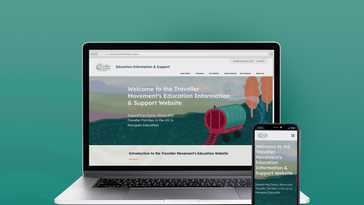Our Mission: Success at School
Use This Section to Review the Work We Have Been Doing to Improve Outcomes for Gypsy, Roma and Traveller Children
Part of This Page is Currently Being Updated
Under Partial Review
On 28 March the Government published the ‘Opportunity for all Strong schools with great teachers for your child’ White Paper. The White Paper sets out proposed reforms to the education system focussed on providing an excellent teacher for every child, delivering high standards of curriculum, behaviour and attendance, targeted support for every child that needs it and; a stronger and fairer school system.
The Traveller Movement is currently in the process of responding to this consultation so we have temporarily taken down some of Our Mission while we develop our ideas and recommendations in response to this review.
As we are currently developing our stance in relation to the Government review, we would value hearing about your experiences with schools. Let us know your experiences, whether you just have feedback or if you want to share a bad experience, please reach out. All contributions will be kept confidential and will be used to inform our policy and recommendations to the Government.
Isolation Rooms/ Internal Exclusion
The current use of isolation rooms is to segregate children who have exhibited poor behaviour from the wider school community. The criteria for a pupil being sent to this room is set by the individual school or trust and can be used instantaneously upon the exhibition of poor behaviour or prescribed in advance as a punishment for poor behaviour.
The primary perceived benefit for the use of isolation rooms is to the wider school population, as removing a child who is disrupting the learning of others is beneficial for the wider school population. Schools often refer to the use of these rooms as an opportunity to provide greater and more specialist resources for the pupil, who requires intervention to improve their behaviour.
The Traveller Movement does not oppose the use or the isolation rooms, provided they are used correctly and for a suitable reason. During our casework, we have discovered that isolation rooms are being used to punish children for low-level poor behaviour, for example if a child forgets to bring their notebook to class and can’t purchase a new one, they may end up on the isolation room for the rest of the day. We have also seen instances where a child is placed in an isolation room for prolonged periods due to teachers refusing to teach them, or when the academic department does not think the pupil is able to continue with the subject.
There are circumstances where isolation rooms can be helpful. For example, if a pupil is having an episode or an outburst, which presents a danger or significant disruption to those around them. In these instances, pupils should not be placed in isolation for longer than is necessary, for example, when a pupil has calmed down and has had a chance to speak with a suitable member of staff, they should be permitted to go back to their lessons.
There needs to be a risk assessment to balance the benefit and right of a child to receive their education balanced with the risk to the wider cohort’s education and the disruption the individual pupil may bring. This is not an easy assessment to make, however the right and benefit of the individual child demonstrating disruptive behaviours should be maintained and made clear to all decision-making staff. Additionally, when an assessment is made that the benefit to the class is greater when the disruptive pupil is removed than the benefit to the disruptive pupil receiving their mainstream education that lesson, a more suitable solution or provision should be preferred, such as the use of a good on-site inclusion units for children who are often disruptive in lessons.
For those children who persistently disruptive at a low to medium level, other more appropriate measures, such as a placement in an on-site inclusion unit, or special educational intervention and assessment would be more productive in correcting the behaviour.
Regarding the prescription of isolation room in advance, it is rare that this punishment will meet the risk assessment test, set out below, which is to ensure the disruption to a pupil’s education when access to their usual lesson format is removed is less than the disruption to the education of their peers when they are present. It is also worth noting, that should this risk assessment still prove that usual lesson format should be removed from a child for a period of time, a more suitable provision should be considered, as there is likely to be a more complex issue present, which isolation rooms alone will not fix and may even exacerbate the disruption and delay the provision which can correct poor behaviour.
The Traveller Movement have worked with the Department for Education, as well as providing written evidence on this matter, to states our concerns that Gypsy, Roma and Traveller children are being placed in isolation rooms away from their peers, either through retaliatory action against racist bullying and harassment or via conscious or unconscious prejudice towards those children with traveller backgrounds. Once again it is important for us to state that the use of these rooms should be ultimately for the protection, safety and well-being of the wider school community and should only ever be used with the approach that this intervention should last no longer than necessary.
The most significant concern about the improper use of isolation rooms is that children, especially those children from Gypsy, Roma and Traveller backgrounds, are being removed from their peers and their access to mainstream education, which has a wider social consequence of further social an ethnic isolation between communities, which is well reported to be a significant issue for the Gypsy, Roma and Traveller communities.
School Policies and Porcedures
The implementation and maintenance of well-structured and functional policies is vital for effective governance in schools. The overarching aim of every school policy should be to establish an inclusive culture, which ensures continued adherence to the Public Sector Equality Duty (PSED). Under s.149 of the Equality Act 2010, schools have a specific duty to produce both Equality Objectives and Equalities Information documents.
The most significant issue with the implementation of these documents is that they are often undervalued and only produced to satisfy the legal requirement. The relevant legislation and government guidance do not outline sufficient criteria or expectations for the contents of the documents. Therefore, there is great variation of the uses and effectiveness of these documents across the education sector, as well as the wider public sector. For example, the use of the Equalities Information document is often unclear, with different schools adopting vastly different formats. The Public Sector Equality Guidance for Schools in England, produced by the Equality and Human Rights Commission, states that: ‘Schools should publish information that demonstrates how they have met the equality duty. This may include school performance data, anti-bullying policies, a school development plan and equality milestones, curriculum materials, governing body minutes, equality training materials, and parent and pupil surveys.’31 This definition presents a much clearer and effective solution to understanding the contents of the Equalities Information requirement. However, this definition is not widely used by schools as it is not a requirement, and there is no effective regulator of the contents of any of their equality objectives or subsequent information.
Equality and Diversity Policies are non-statutory policies which are implemented by some schools and academies who choose to do so. An Equality & Diversity Policy goes further than the objectives or information as it permits a more diverse approach, which enables a school to establish a clear identity promoting equality and diversity. This policy can also be used to signpost services or link to school procedures which promote inclusion and aim to tackle institutional barriers to education, caused by a lack of equality provision or existing intolerance to protected groups.32 There is huge value to be gained from implementing this in nurturing an inclusive school environment. The Traveller Movement believes this to be a legislative gap, which could easily be closed by mandating the policy in schools with clear guidance and expectations over the contents, as well as the requirement to review community cohesion strategies and gain community input on the contents of the policy.
Schools are required to implement a behaviour policy in schools, yet very few policies make suitable reference to race. Casework taken on by the Traveller Movement’s Education Advocacy Unit reveals that the racist behaviour of some pupils towards Gypsy, Roma and Traveller pupils often goes unchallenged. Schools are sometimes unaware that Gypsy, Roma and Traveller are protected under race equality legislation, causing Gypsy, Roma and Traveller children to feel unwelcome or unsafe in school. This then impacts attendance rates and educational attainment, and often Gypsy, Roma and Traveller parents feel forced to opt for home education for fear of the treatment their children may face at school. Schools should be required to protect the rights of all children on the basis of their race or religious belief and to set clear standards that all pupils should be equally held to account and protected for bullying under the behaviour policy.
Exclusions are often covered by schools in their behaviour policies. Exclusions have greater legislative coverage when it comes to their use. Currently sections 21 and 22 of the Exclusion from maintained schools, academies and pupil referral units in England states the following:
“Statutory guidance to the head teacher on the exclusion of pupils from groups with disproportionately high rates of exclusion
- The exclusion rates for certain groups of pupils are consistently higher than average. This includes: pupils with SEN; pupils eligible for free school meals; looked after children8; and pupils from certain ethnic groups. The ethnic groups with the highest rates of exclusion are: Gypsy/Roma; Travellers of Irish Heritage; and Caribbean pupils.
- In addition to the approaches on early intervention set out above, the head teacher should consider what extra support might be needed to identify and address the needs of pupils from these groups in order to reduce their risk of exclusion. For example, schools might draw on the support of Traveller Education Services, or other professionals, to help build trust when engaging with families from Traveller communities.”
These sections are currently at risk of removal by the DfE following the release of the updated version at consultation stage. The Suspension and Permanent Exclusion from maintained schools, academies and pupil referral units in England, including pupil movement makes no separate or distinct reference to race, with no context about how race may impact on exclusions and the national issue of disproportionate exclusion rates faced by Gypsy, Roma and Traveller children. We urge the DfE
It is our view that schools should be doing more to promote equality and diversity within their culture. Within schools, this needs to start from the top, with governing bodies, trustees and headteachers implementing effective equality policies, that aim to achieve a desired standard of inclusion, rather than simply existing because it is a requirement. To assist with this, the government should set out clear recommendations for the contents of all policies which relate to matters of equality, and mandate the implementation of Equality and Diversity Policies in schools.
In February and March 2022, the DfE ran a consultation on behaviour standards and school exclusions. As part of this consultation the DfE made clear the importance of school culture in attaining behaviour standards. We would like to see the objective of improving school culture adopted when considering matters on promoting inclusion, equality and diversity.
Recommendations [needs better formatting]
- Set clear criteria for schools to follow to ensure Equality Objectives and Equalities Information documents are used effectively and not just provided as a tick box matter.
- Make Equality & Diversity Policies mandatory in schools.
- Ensure race is considered in behaviour policies
- Specific reference to GRT pupils and the racial disparities faced when accessing education, and especially when a pupil is facing exclusion.


